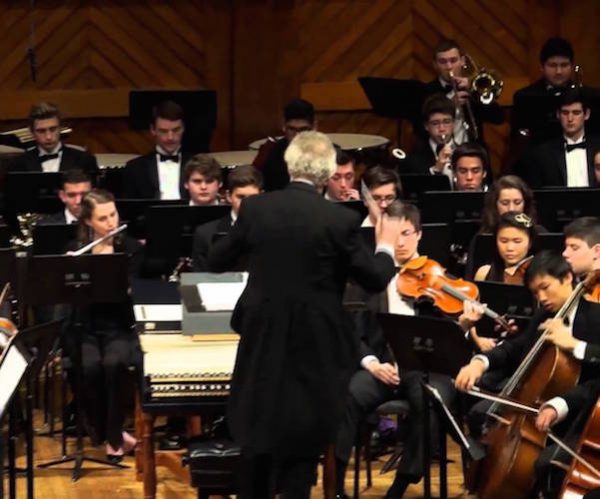Concert Review: Boston Philharmonic Youth Orchestra at Sanders Theater
Rarely in my experience has Charles Ives’s visionary score sounded so fired with purpose.

Benjamin Zander conducing the Boston Philharmonic Youth Orchestra. Photo:YouTube.
By Jonathan Blumhofer
The Boston Philharmonic Youth Orchestra’s (BPYO) season-finale at Sanders Theater Sunday afternoon wasn’t a grim affair, certainly. But it was tinged by various strains of melancholy.
On the one hand, there was poignancy of a deeply personal variety, as represented by Charles Ives’s The Unanswered Question and the group’s encore of “Nimrod,” from Elgar’s Enigma Variations.
The BPYO gave the Ives the full spatial treatment: strings behind the stage in the hall’s lobby, the solo trumpet up in the balcony, the four flutes front-and-center on stage. It was prepared and led by John Heiss, and dedicated to the memory of the conductor’s son, Frank, who passed away suddenly a few weeks ago.
Rarely in my experience has Ives’s visionary score sounded so fired with purpose. There was a lustrous shimmer to the strings’ tone, thanks to the room’s bright acoustic; it sounded like they were playing from another world. Elmer Churampi intoned the trumpet’s repeated queries with golden tone and warmth. And the flute quartet’s replies to those inquisitions were filled with spirit.
The Elgar, too, received an exquisitely-balanced, note-perfect reading that was steeped in nobility and sadness. Played in honor of orchestra members leaving the ensemble after June’s European tour, it was, as BPYO director (and conductor of the rest of the afternoon’s program) Benjamin Zander noted, the last time this particular ensemble would play together in Boston. Bar-for-bar, their “Nimrod” was, appropriately, one of the best orchestral performances I’ve heard all season.
Then there was wistfulness of the more abstract variety that’s found in the same composer’s Cello Concerto. A 1919 score that bears the scars of the Great War, it’s a piece that navigates some turbulent emotional waters and, though he lived for fifteen more years, all but marked the end of Elgar’s compositional career.
Sunday’s soloist was Zuill Bailey, a charismatic cellist who’s playing sometimes takes after the Glenn Gould manner – that is to say, physically present with grunts, intense breaths, and the like at especially dramatic moments (no humming along as yet, but some nifty bow flourishes at the ends of phrases).
His reading of the part was brooding and passionate in the outer movements, agile and incredibly precise in the stratospheric moments in the blistering second, and marked by plenty of momentum in the short, lyrical third.
The BPYO matched him expertly: balances were good throughout and, whether fast or slow, bright or dark, the orchestra’s articulations fit hand-in-glove with Bailey’s. There was some conspicuously fine woodwind playing to be found in the Concerto’s second movement and Zander’s direction ensured that the score’s many recurring motives made coherent structural sense.
Ravel’s La valse, another post-World War 1 memorial-ish piece, opened the concert. A Technicolor orchestral essay, it’s a work that can be downright chilling – Alan Gilbert led the Boston Symphony in a harrowing account of the score a few years back – or played up more for color.
Sunday’s reading ended up leaning more in the latter direction than not, though the opening bars and some of the climaxes near the end sounded ominous enough. Overall, the BPYO’s performance was vibrant, highlighted by elegant colors (with, again, some fantastical, shimmering playing from the woodwinds) and a tight sense of rhythm.
This La valse was accompanied by a specially-prepared animation made for this concert by the composer and software engineer Stephen Malinowski. In it, each gesture and phrase of the score was represented, on-screen above the stage, by an array of geometric shapes – kind of like a totally abstract scene from Fantasia. It wasn’t entirely necessary or unduly distracting, though, if it provides an in for newcomers to Ravel, so much the better.
There were no visual aids to accompany the afternoon’s other programmatic work, Richard Strauss’s Till Eulenspiegel.
Zander drew a spirited rendering of Strauss’s impish anti-hero from the BPYO, anchored by a series of impressively-executed solos from the orchestra’s first chairs: Diego Bacigalupe’s raucous turns on the E-flat clarinet, Mitsuru Yonezaki’s elegant violin playing, and Joseph Cradler’s stirring account of the famous horn line chief among them.
A tentative moment or two in the music’s rhythmic thickets notwithstanding, this was also a strikingly clear realization of a piece that’s always busy and moving, and always not on the strong beat. Zander’s interpretation subtly highlighted the score’s two main themes for Till while filling the various scenes (Till with the priests, Till’s serenade, Till’s argument with the pedants, etc.) with wit and charm.
The orchestra’s upcoming European tour (for which it’s currently raising funds) includes just one piece from Sunday afternoon, La valse. Two more works fill out what is, in sum, a very ambitious slate: George Butterworth’s The Banks of Green Willow and Mahler’s Ninth Symphony. To judge from a recording of March’s Mahler performance and Sunday’s Ravel, they’ll do the trio proud.
Jonathan Blumhofer is a composer and violist who has been active in the greater Boston area since 2004. His music has received numerous awards and been performed by various ensembles, including the American Composers Orchestra, Kiev Philharmonic, Camerata Chicago, Xanthos Ensemble, and Juventas New Music Group. Since receiving his doctorate from Boston University in 2010, Jon has taught at Clark University, Worcester Polytechnic Institute, and online for the University of Phoenix, in addition to writing music criticism for the Worcester Telegram & Gazette.
